► Britain’s newest sports car takes on the old dog
► McLaren 570S vs Porsche 911 Turbo S
► Is the Porsche the champ anymore?
Estoril Circuit, Portugal. Today they meet as rivals, McLaren and Porsche, 570S and 911 Turbo. Britain’s newest sports car and Germany’s longest lived, prowling through the sopping wet paddock of a storied circuit once a mainstay of the Grand Prix calendar, now a mere footnote in its history. But almost exactly 31 years ago on this very tarmac, it was a different story. A story about the collective might of German and British motorsport brains working together to produce a car that decimated the opposition. A story about the closest F1 championship in the history of the sport.
By October 1984, and the last race of the year, McLaren’s Porsche-engined MP2/3 had dominated the season, the constructor’s championship already firmly in the bag following a 1-2 win at Zandvoort three rounds earlier. But the real excitement was in the drivers’ championship. Veteran champion Niki Lauda, lured out of retirement by McLaren for the 1982 season but so far unable to claim his third drivers’ title, was paired with rising French star Alain Prost, chomping at the bit to get his first.
There’s an analogy in there somewhere. Although it’s four years since McLaren Automotive launched its first car, and the quality, ability and capacity of those cars to thrill has improved with every year, this is still a young company. Like Prost in ’84, it’s still learning, and it’s still looking for its first decisive comparison test victory in this magazine.
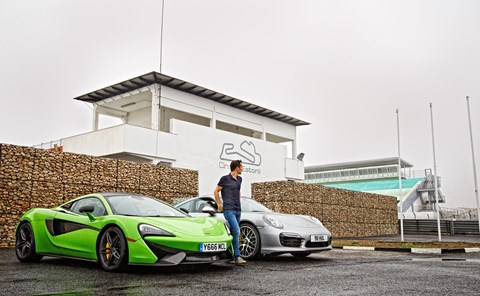
Porsche meanwhile, the wise old man of sports cars, has been making 911s for 52 years; Turbos for over 40. Straddling the line between pure sports cars and laid-back GTs, the 911 isn’t merely a great backroad scratcher, it’s an everyday proposition with space for junk, visibility and reliability. Little wonder it’s the default choice, and was always the car in the 570 development team’s crosshairs.
‘We had 911s in the studio during the process to make sure our car was at least as good,’ McLaren’s design chief, Frank Stephenson had told me earlier. ‘The idea was to make it do everything the 911 can do but better. It’s almost like we started from the inside out. We looked at visibility, comfort, storage capabilities, everything like that had to be the first priority. When you look at the pyramid, the base was usability.’
Over the next couple of days we’ll be putting that to the test, piling on motorway miles, slicing through city traffic and carving up some fast open roads up and down the length of Portugal. And since these aren’t fair-weather sports cars we’ll be taking in all sorts of weather conditions, from torrential rain to even torrentialler rain.
That we’d be bringing a 911 to the Faro launch was a given. But which 911? A Top-Trumps-style investigation reveals the Turbo S to be as bang on the money as it is on the power, which is why CAR’s James Taylor is on his way from the UK in one as we make our way north from Faro in the McLaren. Bringing an extra 39bhp to the table for a £21,522 premium over its non-S brother, the 911 Turbo S costs £142,120 and delivers 552bhp. McLaren’s 570S (there’s also a 540C for £126k from spring 2016) makes 562bhp and will set you back £143,250. Not much in that, you’ll agree, and though the Porsche’s flat-six gives its four driveshafts a 553lb ft Chinese burn, and the McLaren inflicts a comparatively limp-wristed 443lb ft attack on its two, the corpulent German weighs in at 1680kg, or 250kg more than the Brit.
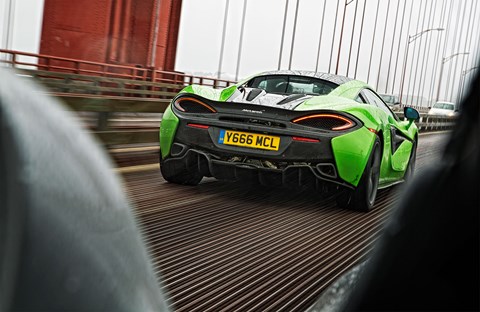
On-paper figures put the Porsche a tenth ahead to 62mph, at 3.1sec, but its 198mph top speed falls 6mph short. That’s close enough to be inconsequential, but my shove-in-the-back-o-meter is telling me that the McLaren is a decisively more savage accelerator. Not quite as savage as the 641bhp 650S, but quick enough to press me deep into the bucket seat when the blowers start boosting. It likes to rev too, pulling to 8500rpm, long after the 911 has given up. Later, a more thorough dig through the 570 technical info turns up 0-124mph figures that bear this out. Porsche: 10.3sec, McLaren: 9.5sec. Lamborghini’s £180k Huracan, by the way, needs 9.9…
The leveller today though is the weather. That and the Porsche’s four-wheel-drive system. As we cruise down the sopping wet IC15 heading for Lisbon, Portugal’s shabby chic capital, I radio James telling him to pull alongside for a rolling drag race. When the hammers drop, so does the 570S, by a couple of car lengths as the all-wheel-drive Porsche storms ahead leaving the McLaren struggling for purchase on the slimy bitumen.
Four-wheel drive is but one of the ways these cars differ from one another. Under dramatically disparate skins they’re every bit as different as they look, a shared 3.8-litre capacity and use of twin turbochargers about the only common connections. A two-plus-two with its engine slung unfashionably far beyond the rear axle, the 911 is constructed around an aluminium-intensive steel structure. A pumped up version of the regular 991, it looks too similar at the front, but the way the rear tyres tuck into those huge arches is exquisite. Swollen? Blistered? Anaphylactic shock, more like.
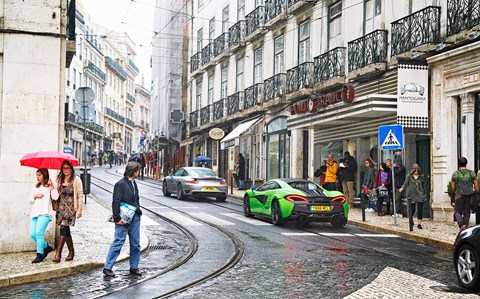
But even a booty like that isn’t enough to garner it much attention as we pick our way through streets that mix tiled facades like a 1970s kitchen, and peeling paint. All eyes are on the McLaren. I doubt most of those eyes know this is the baby McLaren, and many probably don’t know what it is at all. They almost certainly won’t know that it’s built around a carbonfibre chassis tub and flat-plane-crank V8 that can trace its parentage to the mighty P1 hypercar. They might have noticed that the softer rear end styling, with its wraparound superformed aluminium panels and coquettish lamps, seems surprisingly non-threatening – a deliberate attempt to target female customers. But all they really know, or think they do, is that the green car, with its Ferrari-esque styling, its better-than-Ferrari dihedral doors and its growly engine, is both faster and significantly more expensive. Only we know that they cost almost exactly the same (or do they? see panel, left).
Looking like a million dollars when you’ve only spent two-fifty has undeniable appeal, but driving cars like the 570 in town has its problems, particularly in a country so deprived of tasty metal as Portugal. Thumbs-ups and camera phones I can live with, but when you’ve got people banging on the window like you’re some kind of scab breaking through a picket line, demanding you blip the throttle in traffic, you start to wonder whether the 911’s seat isn’t the more appealing.
And that’s no reflection on the strides McLaren has made to deliver on its usability promise. The carbon tub’s vastly lower sill compared with that in the 650S, together with a more generous door swing means it’s far easier to get in and out of than its sibling. Not easy, but easier. The visibility is generous too, both ahead, to the side and through the letterbox rear window, though the front wing peaks aren’t as obvious as in its big brother, making it harder to place on the road, whether you’re carving through the countryside or dodging Lisbon’s ancient trams.
The relationship between seat, wheel and pedals is perfect though, the new digital instrument display clear, and now featuring turn-by-turn navigation instructions to supplement the main map display in the tunnel. The new physical shortcut buttons to functions accessed via that central Iris infotainment screen are welcome, as is the shift in the RND gearchange buttons, which have been moved sufficiently forward in the tunnel that you no longer need to operate them with your elbow. It’s tangibly less spacey in here than something like a Ferrari 488, but that also contributes to a wieldy feel when threading through the city. And in relative terms, it’s not cramped. In fact, bizarrely, it’s bigger than the costlier 650S both inside and out. Headroom is good, and while it doesn’t have 911’s rear-seat-cum luggage dump, the front boot is large and there’s a generous shelf behind the seats for more squashy bags.
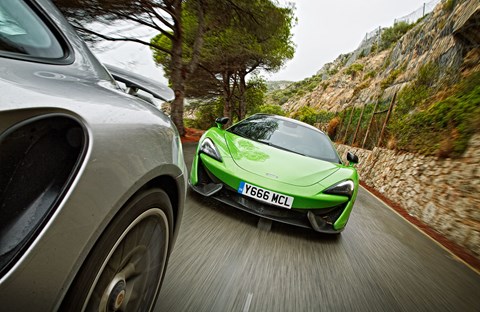
Like the Turbo S, the 570 comes only with a seven-speed dual-clutch transmission, which takes some of the sting out Lisbon’s stop/start traffic. But the pedal effort required to clamp the McLaren’s standard carbon discs sufficiently hard to keep the transmission creep at bay is annoyingly high considering its intended use. Imagine riding a bike with only a right pedal attached to the crank and you’ve probably got a good approximation of what it’ll feel like in LA traffic. Other small niggles include noisy windscreen wipers, a whistling from the air-con that sounds like someone tapping out War and Peace in morse code, and a badly positioned brake cooling duct that hangs way below the front wishbones where it’s just begging to be destroyed by potholes and kerbs. I obliged. In McLaren’s defence it claims to be aware of these problems on what was a pre-production car and assures us they’ll be fixed before customers take delivery. We’ll see.
After a pause for pictures I switch to the 911, and it feels like I’ve jumped into a Cayenne by mistake. Taller by 94mm, and (subjectively, if not objectively) significantly wider, it’s instantly less alien. It’s a handsome interior, but the great swathe of buttons below the gear selector is fussy, the column stalks feel as flimsy as they have for decades, and it’s surprising to find that there are fewer useful cubbies for phones, wallets and coffees than in the McLaren, or at least located in the centre console where you really want them. And the comforting familiarity of the design and materials is also its downfall. It doesn’t feel that much more special to look at and sit in than a Cayman costing a third as much.
Porsche fans have heard it all before. Drivers, they’ll counter, are less interested in vanity than profanity – the kind of expletives that might escape your mouth every time you hit a great bit of road, ask the Turbo to dig deep, and are reminded how great this chassis and engine combination really is. So the following morning we’re briefly back on the motorway, to find us some of those finding-out roads. Despite James Taylor complaining of a numb arse on the way down through Spain, the 911 feels comfortable and composed at a cruise, its boxer six humming away unobtrusively in the background, occasionally cutting in and out as it makes use of the coasting function that helps Porsche claim an impressive 29.4mpg and 227g/km. Despite packing McLaren’s first stop/start system, the lighter 570 trails on 25.4mpg and 258g/km. Refined at UK speeds, above 100mph it’s noticeably more boomy too, something to bear in mind if you’re an autobahn-dwelling McLar-hun.
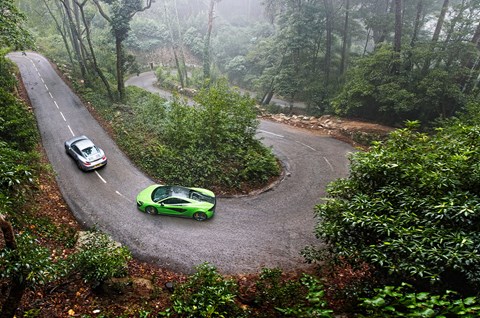
As grey turns to green, the urban sprawl thinning and eventually giving way to the woody climbs of the Sintra-Cascais National Park, each car grabs the increasingly frequent chances to stretch its legs. I’ve driven the 911 Turbo S before, but I’m no less shocked by how wieldy it feels. Some of that precision must be down to adaptive engine mounts specific to the S, which also gets half an inch wider centre-lock wheels. But for me the four-wheel-steer system that’s common to both Turbos is where this blown 911 stepped up a gear from its predecessors. In town you can see the rear wheel twisting outwards in your side mirror
to improve manoeuvrability when parking. Up here in the hills you can feel it pointing the car into each corner, imbuing it with an almost mid-engined zeal for changing direction. Slow in/fast out has always been the 911 mantra, but that goes out the window with torque-vectoring four-wheel-steer agility and four-wheel-drive traction doing their best buddy movie impression. Fast in, faster in the middle and utterly batsh*t on the exit is the new party line.
The standard ceramics give a beautifully firm pedal feel and the PDK ’box’s shift mapping is excellent, but it’s not all good news. The steering feels disappointingly ill-defined around the straight ahead, the throttle response is utterly soporific unless you’ve got the Sport button engaged, and even then the flat-six makes you wait before delivering.
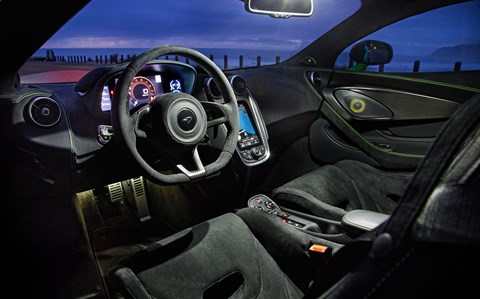
The McLaren feels similarly less than immediate when you summon the power, a combination of turbo lag and peak torque not arriving until 5000rpm. The pedal response is actually pretty good, but sometimes that first modest slug of extra power only serves to push the nose wide, because it’s not the giant kick of thrust you wanted to help the car move around its centreline. It gives the 570 an occasionally soft, imprecise feel until you learn to work with its particular traits, to ensure you’re in the right gear and getting on the gas at the right time.
For me, Ferrari’s 488 GTB and its near zero-lag response has changed the turbocharged game, and both McLaren and Porsche are playing catch up (though I haven’t driven the 991.2). But when it comes to steering, it’s McLaren that leads the class. The weight of the steering, the outstanding on-centre feel, the perfectly judged ratio, even just the shape of the wheel, all contribute to a car that is a joy to drive at any speed in any situation. Whether you’re ambling down a motorway or tearing up B-roads, you never feel less than 100% keyed in, and that’s a rare thing these days, even in this class.
Flick your wrist in either direction and the 570 reminds that it’s lighter than any rival. Reverting to cheaper, lighter, steel springs and anti-roll bars instead of the 650’s hydraulics has had a slightly detrimental effect on ride quality that’s particularly noticeable on Lisbon’s cobbles, but it’s still comfortable, and the control remains intact, giving you the confidence to push deeper and deeper. Though dimensionally bigger than a 650S, you’d swear from the way it moves that the 570 takes up less road real estate. As James says, it feels like the kind of car Lotus would love the Evora 400 to be, given the chance.
McLaren’s twin toggles, one for handling, one for power, make another appearance at the base of the console giving a choice of Normal, Sport and Track in each case. Track’s damping is too tight for these roads, but Sport works perfectly, and following the 675LT’s lead, the ESP system is decoupled from those toggles. So if you do want Track mode’s body control and throttle response, you can now have it while enjoying the ESP safety net. Not that most drivers will need it. Natural balance and a generous steering lock mean the physical hardware is on your side.
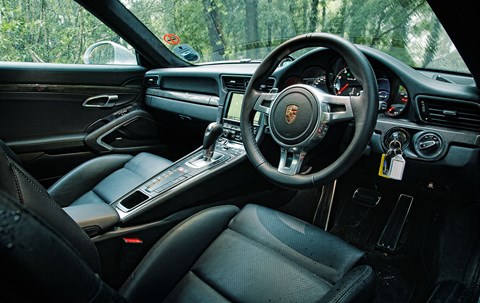
There were no electronic safety nets in Prost and Lauda’s car back in ’84 of course. No paddleshift transmissions either, although the MP4/2 was one of the first F1 cars to employ carbon ceramic brakes. We swing by Estoril one last time before Porsche and McLaren go their separate ways. It’s still tipping it down, but 31 years ago the umbrellas offered shelter from the sun, not the rain. Going in to that final race Prost was second in the driver’s championship but knew he would seal the deal if he finished in the top three, as long as table-topper Lauda trailed by several places. Lauda meanwhile could wrap it up if he came first or second. Trouble was, Prost had qualified on the front row, while his teammate lay back in 11th. But this was Niki Lauda we’re talking about. A man who, eight years earlier had lost his eyelids, most of his ear and almost his life in a Nordschleife fireball but was back on the starting grid just six weeks later. Lauda battled through the field at Estoril, taking advantage of Nigel Mansell’s 51st-lap spin to take second place to Prost’s first, and the championship by half a point – half points having been awarded earlier in the season when Monaco was stopped mid-race with Prost in the lead.
The two remained teammates the following season, one that culminated in the Austrian’s retirement from racing, and the first of the Frenchman’s three world championships. Porsche continued to supply powertrains to McLaren for three further years but they were no match for the Williams-Hondas and McLaren itself switched to Japanese power for 1988. As for Estoril, it hosted a Portugal Grand Prix until 1996, thereafter being dumped from the calendar. The fabulous Autodromo Algarve circuit at Portimao has long been mooted as the right facility to return a GP to Portugal, but there’s one big piece of the puzzle missing: cash. Portugal is still pretty skint.
McLaren Automotive, on the other hand, is in rude health. In profit and in a position to funnel millions of pounds back into research and development for its next generation of cars, McLaren’s road-car arm feels like a company that has really found its feet, found its identity, and grown in confidence. The brilliant 675LT is evidence of that. So is the 570S. But is the 570S good enough to make a better buy than a 911? This might be the most usable McLaren yet, but it still can’t match the Porsche when it comes to ease of use. The 911 is roomier, easier to see out of and requires less effort to drive and own. When I tot up the Porsche’s demerits, the list, as ever, is short.
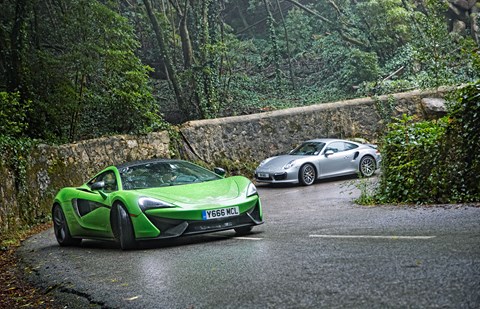
You’ll be making more allowances for the McLaren. Pure sports cars will always ask that of you. But you really could imagine using a 570S every day, and the 50% cheaper PCP deal will be tempting for many. I say many, but while McLaren expects the 570, its de-contented 540 little brother, and the inevitable roofless version that’ll follow, to double Woking’s output, we’re still talking a couple of thousand cars per year to the 911’s 30,000. That rarity alone ensures the McLaren feels like the more special car. But so does the way it drives, and that must be the deciding character in a test like this. It steers so much better, accelerates that bit harder. It just puts a bigger grin on your face more of the time, and makes the Porsche feel, well, a little bit ordinary. And I don’t believe I’ve ever written that before.
You can afford it! How to get a 570S for £995pm
When McLaren heard we were bringing a 911 Turbo there were some raised eyebrows. They’d figured a Carrera S a more natural foe, even though it’s massively down on price, power and performance. McLaren says big league supercars, cars like the P1, are bought with cash, but at 570 level, it’s all on finance. The cost of that finance is based on the car’s depreciation, and because the 570S is predicted to hold on to such a big chunk of its value after three years, McLaren has come up with a pretty enticing PCP package. Okay, so to us mere mortals the numbers are still eye-watering – you drop £39k as a deposit, then pay £995 a month for three years before deciding whether to walk away, or stump up a £90k balloon payment. But a visit to broker4cars.co.uk looking for a Turbo S with the same deposit and same 10,000pa mileage limit, results in a bill for £1736pm, albeit with a smaller balloon (merely hot air-, rather than Zeppelin-sized).
570S vs 650S What’s the difference?
Body & aero
The 570S ditches the 650’s composite body panels for more easily repaired superformed aluminium panels that are heated then blown into a mould. Only the 650S gets active aero in the form of a moveable rear spoiler
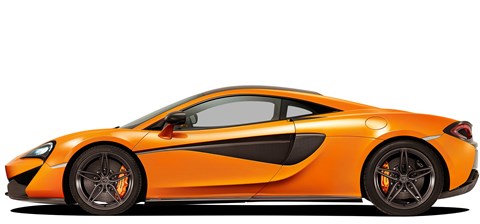
Chassis
Both use a variation of the carbonfibre MonoCell, but the 570S’s is modified with a lowered sill for easier access. Maintaining stiffness at the same time meant adding 5kg of strengthening material to junior’s tub (still only 80kg)
Engine
Every McLaren from 570S to P1 employs a version of the original 12C’s 3.8-litre twin-turbo V8. The 570S makes 562bhp and 443lb ft to the 650S’s 641bhp and 500lb ft. Both are rear-drive via a seven-speed twin-clutch ‘box
Suspension
With its uncanny ability to absorb bumps, hydraulic suspension has always been a key modern McLaren feature. But the 570S uses conventional suspension and anti-roll bars. So no risk of leaks, but more bumps.
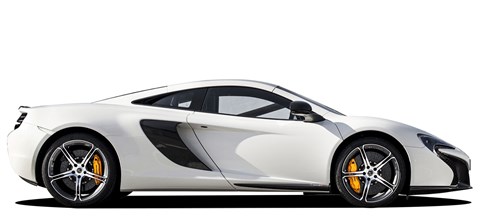
Porsche 911 Turbo S
Price: £142,120
Engine: 3800cc 24v flat 6cyl, 552bhp @ 6500rpm, 553lb ft @ 2200rpm
Transmission: 7-speed dual-clutch, four-wheel drive
Performance: 3.1sec 0-62mph, 198mph, 29.1mpg, 227g/km CO2
Suspension: McPherson struts front, multi-link rear, adaptive dampers
Length/width/height: 4506/1978/1296mm
Weight/made from: 1680kg/steel, aluminium
Fuel tank: 68 litres
Rating: *****
McLaren 570S
Price: £143,250
Engine: 3799cc 32v V8, 562bhp @ 7400rpm, 443lb ft @ 5000rpm
Transmission: 7-speed dual-clutch, rear-wheel drive
Performance: 3.2sec 0-62mph, 204mph, 25.4mpg, 258g/km CO2
Suspension: double wishbones, coil springs, adaptive dampers
Length/width/height: 4530/2095/1202mm
Weight/made from: 1430kg/carbonfibre, aluminium
Fuel tank: 72 litres
Rating: *****